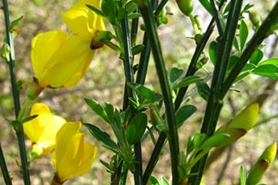Scotch broom
(Cytisus scoparius)
A fast-growing shrub in the legume family that grows to be 3-12’ tall. Branches are greenish-brown with five ridges when young that become smoother and tan as they mature.
Other names for this plant include:
- Common names: English broom, standard broom, broom tops
- Scientific names: Genista scoparius; Sarothamnus scoparius, S. vulgaris; Spartium scoparium
Classification in Wisconsin: Prohibited
- Ecological Threat
-
- Scotch broom is often found in sandy areas such as dunes or beaches where its nitrogen-fixing and stabilizing qualities can risk the natural habitat.
- It is also found along roadsides and pastures where it can readily move into natural areas after disturbances such as fire or logging.
- Slightly toxic and can cause symptoms in animals if large quantities are eaten.
- Identification
-
Leaves: The leaves are compound, alternate, and have three leaflets: dark green above and pale green and hairy below. As leaves move further up the plant, they become sessile and maybe a tiny leaf.
Flowers: These are generally bright yellow but may also appear a two-toned yellow or even have a purple ting or red streak. The pea-like flowers appear singly or in pairs in the upper leaf axils and bloom from late March to June.
Fruits & seeds: Seed pods are flat and have fuzzy edges. Pods are green and turn brown or black in late summer as they mature. Each pod contains 5-8 bean-like seeds viable for 60 years and burst from the pods when they grow.
Roots: A taproot that can exceed 2 feet long with large shallow lateral roots is produced. The scotch broom can also resprout from the root crown.
- Control
-
Mechanical: Small plants can be pulled or dug out; in fire-adapted communities, burning can be effective if done every 2-4 years to deplete the seed bank.
Chemical: Basal bark with triclopyr plus oil soon after flowering; foliar spray with 2,4-D.
- Resources
- Sources for content:
- Czarapata, Elizabeth; Invasive Plants of the Upper Midwest: an illustrated guide to their identification and control. The University of Wisconsin Press. 2005. Pg. 124
- Invasive Plant Atlas of New England: Scotch broom [exit DNR].



